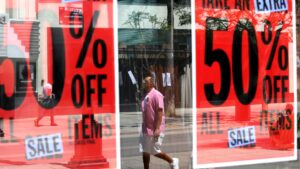Retailers React to Tariff Turmoil: Strategies for Survival in a Changing Market
As consumer sentiment shifts amid economic uncertainty, many retailers are scrambling to adapt. President Donald Trump’s trade policies, particularly the trade war with China, have forced brands to consider novel marketing strategies to safeguard their revenues. At Extreme Investor Network, we dive deep into how retailers are navigating this turbulent landscape and what it means for consumers and investors alike.
Timing is Everything: Buy Now Before Prices Spike
In the face of rising tariffs, retailers like Beis, Bare Necessities, Fashion Nova, and Knix are turning to urgency as a key element of their marketing campaigns. Since the announcement of steep tariffs on various goods, many are promoting "buy now" messages, encouraging consumers to take action before prices increase or items become scarce.
The Crisis Mode
While initial tariff announcements prompted some reprieve—as rates were temporarily lowered for certain countries—the unpredictability of future tariffs has left many retailers in panic mode. In an unpredictable market, it’s challenging for businesses to forecast costs when there’s a constant threat of tariffs looming overhead.
Retail expert Sonia Lapinsky notes the increased volatility has made consumers skittish since early this year. “It’s better to secure 80% of dollars now than to risk zero demand later,” she advises. However, this approach presents a precarious balance between maintaining profit margins and driving sales.
A Double-Edged Sword for Small Businesses
The impact of tariffs varies across the retail landscape, but small brands are particularly vulnerable. Without the extensive supply chains that larger companies like Target and Walmart enjoy, smaller retailers have fewer options to navigate tariff challenges. As Lauren Beitelspacher, a marketing professor, points out, "Tariffs will hit every business, but smaller companies will feel the pinch more significantly."
This sentiment resonates within the financial communities that support these smaller brands. Investors are keenly aware that adjusting to these economic pressures is not just a matter of marketing—it’s often a question of survival.
Creative Campaigns: Humor and Urgency
Some brands, such as luggage company Beis, opted to take a light-hearted approach while still motivating customers to buy now. They candidly informed shoppers that while they did not yet know how prices would change, current pricing is valid "for now." They even joked about considering "company-wide ramen diets" to cope with rising costs.
The use of humor in communication about tariffs is strategic. According to Barbara Kahn, a marketing scholar at Wharton, brands seek to sidestep the political ramifications tied to tariffs. "Humor serves to defuse potential divisiveness while drawing consumers’ attention to good deals," she explains.
The Bigger Picture: Consumer Behavior and Economic Sentiment
Interestingly, the spike in pre-tariff sales could explain why some consumer spending data exceeded projections last month. People who can afford it are purchasing big-ticket items now, anticipating their prices will soon inflate.
In summary, the retail sector is at a pivotal moment, characterized by both challenges and opportunities. Retailers that can adapt and develop innovative marketing strategies will likely fare better than those that remain stagnant. As we monitor consumer behavior and market dynamics at Extreme Investor Network, it’s crucial for both investors and consumers to stay informed about these evolving trends.
Stay tuned for more insights and analysis as we continue to explore the intricate relationship between economics, consumer behavior, and retail strategies.

